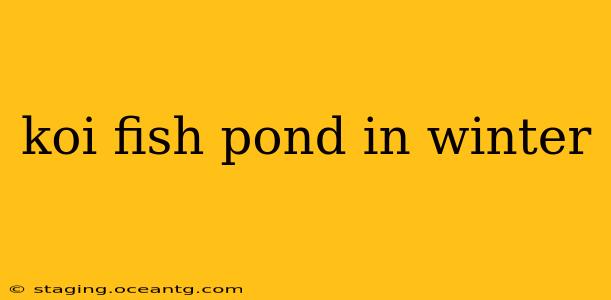Winter presents unique challenges for koi pond owners. The plummeting temperatures and potential for freezing can severely impact the health and survival of your beloved koi. This comprehensive guide will address common concerns and provide expert advice on maintaining a thriving koi pond throughout the winter months.
How Cold Is Too Cold for Koi?
Koi are surprisingly hardy fish, but prolonged exposure to extremely cold temperatures can be lethal. While they can tolerate temperatures down to around 40°F (4°C), prolonged exposure below this temperature significantly increases their risk of hypothermia and death. The ideal winter temperature range for koi is between 40°F and 50°F (4°C and 10°C).
What Happens to Koi in Winter?
As temperatures drop, koi’s metabolism slows down. They become less active, eating less and spending more time at the bottom of the pond seeking warmth. Their immune systems also become weaker, making them more susceptible to diseases. Understanding these changes is crucial for providing appropriate winter care.
How to Protect Your Koi Pond from Freezing
Preventing the pond from completely freezing over is paramount. A completely frozen pond cuts off oxygen supply, leading to fish mortality. Here are several methods to protect your pond:
- Pond De-icer: These devices are submerged in the pond and prevent ice formation by creating a small, open area on the surface.
- Water Circulation: Aeration and filtration systems, even if running at a reduced capacity, help to prevent the water from stagnating and ensure oxygen circulation.
- Insulation: Insulating materials like pond blankets or floating thermal covers can significantly reduce heat loss from the water's surface. These are especially beneficial in very cold climates.
- Pond Depth: Deeper ponds are naturally better insulated and less prone to freezing solid.
Do Koi Need to Be Fed in Winter?
Koi's dietary needs change dramatically in winter. Their metabolism slows, and they require significantly less food. Overfeeding can lead to uneaten food decaying and polluting the water, harming water quality and potentially leading to ammonia build-up, a serious threat to the fish's health. It's recommended to drastically reduce feeding or completely cease feeding during the coldest months, depending on the temperature and your koi's activity level. Observe your fish; if they are not actively seeking food, reduce or stop feeding.
How Do I Keep My Koi Pond Clean in Winter?
Maintaining water quality is crucial even in winter. While less waste is produced due to reduced feeding, leaves and debris still accumulate. Regularly remove leaves and debris from the pond surface to prevent decomposition and ensure sufficient oxygen levels. If possible, continue to filter your pond, though you may reduce the pump's power to conserve energy.
Should I Cover My Koi Pond in Winter?
Covering your pond offers several advantages, including reducing heat loss, preventing debris from falling in, and minimizing evaporation. However, ensure the cover is breathable to allow for gas exchange and prevent the buildup of harmful gases.
When Should I Start Winterizing My Koi Pond?
The optimal time to begin winterizing your koi pond depends on your climate. Start preparing your pond for winter when temperatures consistently drop below 50°F (10°C). This allows for a gradual adjustment and ensures you are fully prepared before the onset of freezing temperatures.
What are the Signs of a Healthy Koi in Winter?
A healthy koi in winter will exhibit minimal activity, but will still be responsive to stimuli. They should not show signs of lethargy, labored breathing, or unusual discoloration. Monitor your fish regularly for any signs of distress. If you observe any problems, seek veterinary advice immediately.
Conclusion
Winterizing your koi pond requires careful planning and attention to detail. By implementing the strategies outlined above, you can significantly increase the chances of your koi surviving the winter months and thriving once spring arrives. Remember to regularly monitor your pond and your koi's health, and always seek professional advice if you have any concerns.
